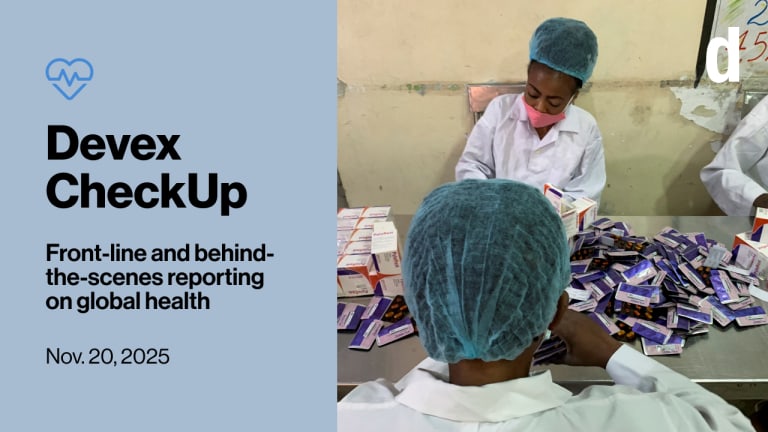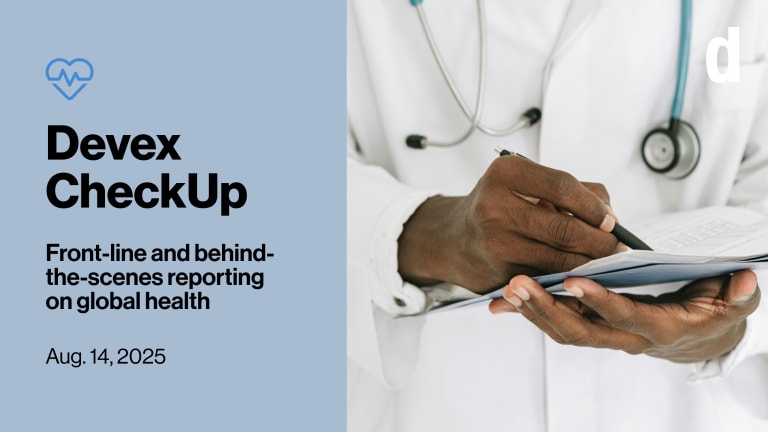
When my colleagues flew to Geneva over the weekend, one question they had in mind was what happens next with the pandemic treaty and amendments to the International Health Regulations, after countries failed to reach consensus on both documents last week?
But as you read this, I’m afraid we haven’t yet gotten a clear answer. Member states agreed to create a drafting group — yes, yet another process — to reconcile their differences on how to continue, and how long to extend, the treaty negotiations. The same group is also responsible for resolving outstanding issues in proposed IHR amendments.
This is a preview of Devex CheckUp
Sign up to this newsletter for exclusive global health news and insider insights, in your inbox every Thursday.
They are expected to present their report to the World Health Assembly on Friday, a tight timeline for an already busy and packed week in Geneva.
The trajectory of these two documents is unclear at the moment, but could be very different.
While countries wrangle over whether to extend treaty negotiations for six to 12 months, there is an understanding that negotiations should continue. But on the IHR amendments, there are strong calls from several countries to get the job done this week.
Will they? We’ll wait for the white smoke from the Palais des Nations.
Read: The holdouts on negotiating amendments to the IHR at WHA77
Making it rain
In a new look for the agency, the World Health Organization launched its first investment round at the WHA, hoping to raise $11.1 billion to finance its work over the next four years.
It’s not quite as daunting as it seems: WHO expects governments to contribute $4 billion in membership dues. But the agency still needs donor governments and private sector donors to shake an additional $7.1 billion out of the couch cushions.
After spending decades at the mercy of unpredictable donor funds or receiving money that is tied to specific projects, WHO is looking for stability, flexibility, and to limit the oversized role of donors in the agency’s decision-making, as my colleague Sara Jerving explains. WHO officials want to end a funding structure that has seen the agency approve activities, only for the work to go unfunded.
There will be a fundraising event in November and the relatively new WHO Foundation is working behind the scenes to broaden the private donor funding base and to raise private capital for the investment round.
Read: WHO launches first investment round, asking for $11 billion
Tapped out
WHO isn’t the only institution on the fundraising trail. The Pandemic Fund, which is hosted by the World Bank, is looking for $2 billion to underwrite its priorities over the next five years, even as it seeks a more sustainable financing model.
Established in the wake of the COVID-19 pandemic, the fund is meant to offer dedicated financing to countries looking to strengthen their pandemic prevention, preparedness, and response capacities. It managed to raise $2 billion toward those efforts already, which allowed it to award $338 million in grants to 37 countries last year.
Even if the fund hits its target, it is unlikely it can deliver on the $4.5 billion in funding requests it received in its recently closed second round of financing. And it’s well short of the $12 billion-$15 billion its leaders estimate countries need to build their PPPR capacity, a third of which needs to come from international financing.
Read: Pandemic Fund eyes $2B funding target to kick-start new strategic plan
Background reading: Where does the Pandemic Fund stand in its second year? (Pro)
+ A Devex Pro membership gives you access to all our expert analyses, funding data, globaldev’s largest job board, exclusive events, networking opportunities at our summits, and more. Not a Pro member yet? Start your 15-day free trial today.
Making plans
Dr. Sania Nishtar, who took over as head of Gavi, the Vaccine Alliance, only nine weeks ago, is already working on several plans for the future of the organization.
The institution is crafting a five-year strategy that looks to scale innovations, simplify grantmaking, empower local stakeholders, and enhance global coordination for seamless vaccine delivery, Nishtar explained this week during a Devex event on the sidelines of WHA77.
At the same time, she is “putting the finishing touches to a six-month plan that will transform the Gavi secretariat’s capacities and capabilities to deliver that strategy,” she wrote in an opinion piece for Devex this week.
Taken together, the ultimate goal of all of this strategizing is to halve the global number of children who have never received a single dose of any vaccine over the next five years, but also position immunization services as a starting point for health workers to deliver a comprehensive array of services.
And if that wasn’t enough, Nishtar also has her eye on the long game, looking for openings to harness emerging technologies over the next 20 to 50 years to benefit “underprivileged populations.” She hopes the upcoming launch of the African Vaccine Manufacturing Accelerator, which aims to boost local manufacturing, can demonstrate exactly how Gavi can work together with partners to deliver on these opportunities.
Read: Gavi, the Vaccine Alliance, has no ‘magic wand,’ says new CEO
Opinion: Why immunization is key to resilience in a changing world
Common ground
“Are we making the drug only for a few or are we making it for everyone?”
— Dr. Victor Dzau, president, the U.S. National Academy of MedicineInnovation may create tremendous excitement and possibility to improve people’s health, Dzau said during the Devex CheckUp @ WHA 77 event yesterday, but it must be accompanied by efforts to ensure everyone gains access new technologies, such as CRISPR, which is now being used to treat everything from cancer to sickle cell disease.
Dzau asked the audience at the event whether they thought it was possible that the Chan Zuckerberg Initiative’s goal to cure, manage, or end all diseases by the end of the century was even possible.
Not a single person raised their hand.
“You’re wrong,” he replied.
The question, Dzau said, is whether everyone will benefit. “I think in global health, that's what we need to focus on,” he said. “How do we make sure everybody can have access and benefit from all the advances?”
He also called for policies that will ensure equitable access, while highlighting the role of civil society organizations in ensuring that innovators adhere to their promises of equity.
Background reading: How should Mark Zuckerberg and Priscilla Chan spend $3B to end disease?
Rat race?
Are donors promoting an unsustainable localization agenda? One Somali health official thinks so.
Speaking at a USAID localization side event at WHA, Abdifatah Ahmed Mohamed, director of policy and planning at the Federal Ministry of Health in Somalia, called for a “paradigm shift within the donor organizations.” He argued that donors are fostering an unsustainable model by primarily partnering with local NGOs while neglecting government ministries.
Your next job?
Principal Programme Policy and Strategy Officer (Fixed-term)
African Union Commission (AU)
Ethiopia
“For me, sustainability is building local capacity through the national institutions because we are accountable to the community,” he said. “This cycle of keeping NGOs, who are both local and international NGOs in the cycle, diminishes the legitimacy of local governmental institutions in front of the local communities.”
Mohamed added that donors should support governments in capacity building instead of citing lack of capacity as a reason to work around them.
“When the donors come to us, they tell us, you don't have the capacity. Actually, that's why you're here,” he said to some applause. “If we, the Ministry of Health, have the capacity, we don't need you, we don't need your money, we don't need your interventions. So let us be realistic, and try to build number one, the capacity of local authorities, and maybe even support local authorities to use local NGOs so that services can be close to community. That's when we can talk about sustainability.”
In response, Michele Sumilas, assistant to the administrator of the Bureau for Planning, Learning and Resource Management at USAID, said the agency is “looking into” funding local governments. She added that there was a lot of focus on national governments, but the agency is now thinking about regional and local governments too and is currently working with almost all of the local county governments in Kenya.
+ Pro members can get the most out of our USAID coverage, including its localization progress.
What we’re reading
A blow-by-blow account of how and why negotiators failed to reach a pandemic agreement. [Think Global Health]
Russia, Egypt, Iran, and Nigeria are among the countries at WHA objecting to terms such as “gender responsive” and “advancing gender mainstreaming.” [Health Policy Watch]
An Israeli airstrike Sunday on the Gaza town of Rafah set ablaze an encampment that was meant to be protected, killing 45 Palestinians and injuring 200 more. [NPR]
Jenny Lei Ravelo and Rumbi Chakamba contributed to this edition of Devex CheckUp.








